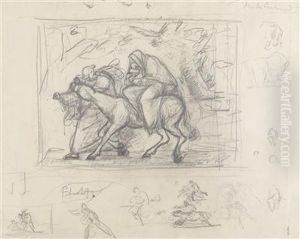Theodor Charlemont Paintings
Theodor Charlemont was an Austrian painter and graphic artist, born on March 1, 1849, in Mattsee near Salzburg. Son of the painter Johann Charlemont and brother to Hugo Charlemont, a well-known landscape and genre painter, Theodor was part of an artistic family and he received his first artistic training from his father. His early exposure to the arts set the foundation for his future career.
Charlemont moved to Vienna to further his education and became a student at the Academy of Fine Arts Vienna, where he studied under the guidance of renowned artists such as Eduard von Engerth and Anselm Feuerbach. After completing his studies in Vienna, he traveled extensively through Europe, which was common for artists of the time to gain exposure to different styles and techniques. His travels took him to Germany, Italy, and eventually to Paris, which was the center of the art world in the late 19th century.
In Paris, Charlemont was influenced by the academic painting tradition, and he became well-versed in historical and genre painting, which was popular among the Parisian art scene. He also came into contact with the Orientalist style, which was gaining popularity at the time, and this influence is visible in some of his works. Theodor Charlemont's most recognized work is 'The Moorish Chief' (1878), which displays his skill in portraying exotic subjects with a high degree of realism and attention to detail.
During his career, Charlemont exhibited at various salons and was well-received by critics and the public alike. His works were appreciated for their technical skill and their ability to capture the essence of the subjects he portrayed. Although not as widely known today as some of his contemporaries, Theodor Charlemont made a significant contribution to the art world of his time.
Theodor Charlemont remained active as an artist until his death on May 7, 1907, in Vienna. His legacy is preserved in his paintings, which can be found in various art collections and museums, offering insight into the academic and Orientalist art movements of the late 19th century.
